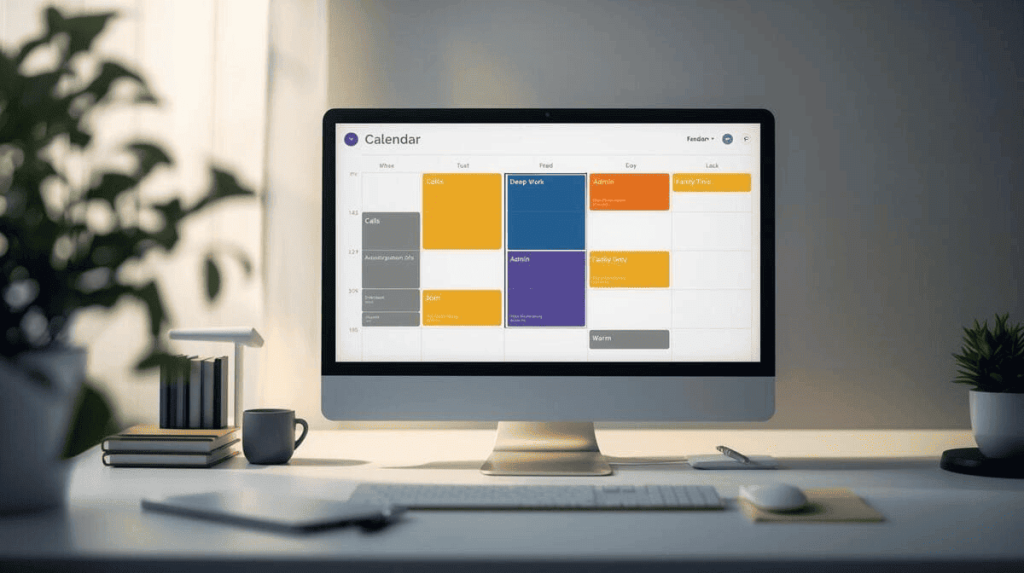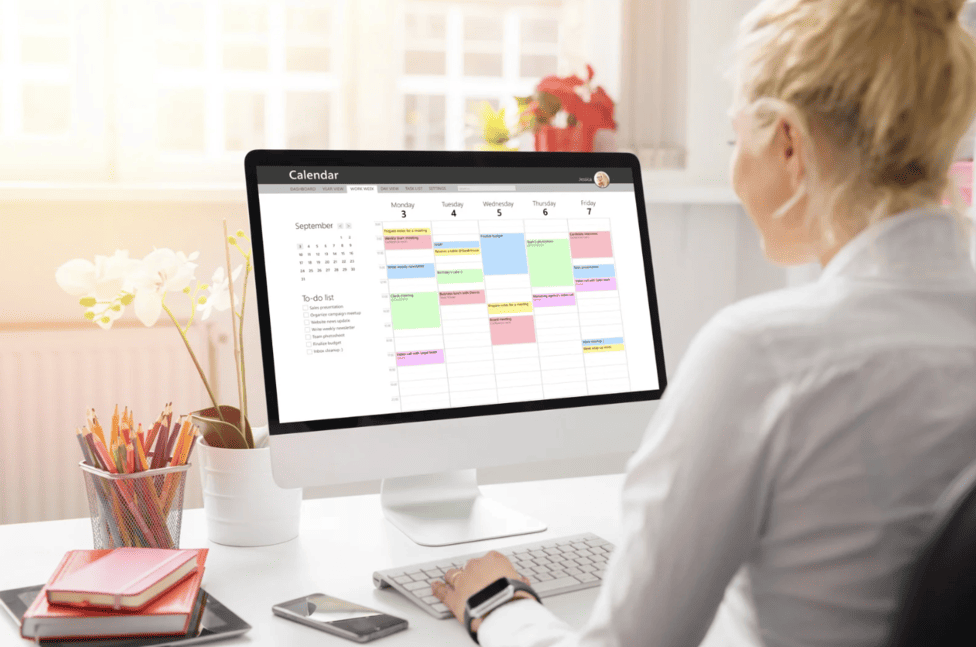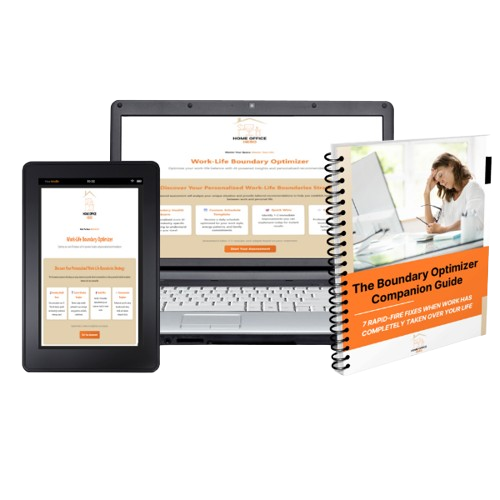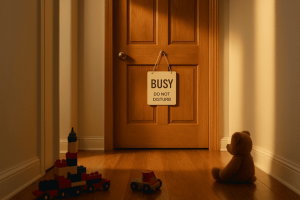After 10 years of professional rugby and 6 years building my agency while raising a young child, here’s what nobody tells you about work-life balance: it doesn’t exist.
At least, not in the way we’ve been told to think about it.
I learned this the hard way. Picture this: It’s 2019, and I’m sitting in my home office—which is really just the corner of our bedroom—trying to finish a client proposal while my son plays (loudly) in the next room. My phone buzzes with a Slack message. Then another. Then three more. My partner pops in to ask about dinner plans.
I close my laptop in frustration and think, “I’m failing at work because I’m distracted by home. I’m failing at home because I’m distracted by work. I’m failing at everything.”
Sound familiar?
The traditional concept of work-life balance—this perfect 50/50 split where work stays at work and home stays at home—was designed for a world where those two places were physically separate. But when you’re a remote working parent, solopreneur, or business owner? That boundary doesn’t exist. Your office IS your home. Your work hours OVERLAP with parenting duties. And that old definition of balance? It just makes you feel inadequate.
Here’s the truth I wish someone had told me earlier: You don’t need better balance. You need better harmony. And in this guide, I’m going to show you exactly how to create it.
Why Traditional Work-Life Balance Doesn’t Work for Remote Parents
Let’s be honest about something: most work-life balance advice is written by people who’ve never tried to take a Zoom call while simultaneously preventing a toddler from eating crayons.
The traditional model assumes clear boundaries. You leave home, go to an office, work for 8 hours, then return home and “switch off.” But when you’re working from home with kids? Those boundaries are as real as the line between your “office” (the kitchen table) and your “home” (also the kitchen table).
I tried the traditional approach for my first year working from home. I set strict hours: 9-5, no exceptions. I told my family not to interrupt me. I even put a sign on my office door (yes, the bedroom door) that said “Dad’s Working.”
It lasted about three days.
Then came the client emergency at 7pm. The school pickup that couldn’t be rescheduled. The sick child who needed me at 2pm. The burst of creative energy at 10pm that I couldn’t ignore. The important call that happened during breakfast because my client was in a different timezone.
Work-life balance suggests you can separate these worlds. Work-life harmony acknowledges they’re already integrated—and helps you manage that reality instead of fighting it.
Here’s what the research shows: Remote working parents who strive for traditional “balance” report higher stress levels and lower satisfaction than those who embrace integration. Why? Because they’re constantly measuring themselves against an impossible standard and finding themselves lacking.
The shift from balance to harmony isn’t just semantic—it’s transformational. And it starts with understanding what harmony actually means.

The Shift from Balance to Harmony: What It Actually Means
After my car accident in 2019, I had a lot of time to think. Too much time, honestly. I couldn’t work my normal hours. I couldn’t do the physical activities I’d relied on for stress relief. I had to completely reimagine how work and life could coexist.
That’s when it hit me: I’d been treating work and life like two opponents in a rugby match, constantly battling for territory. But what if they could be more like… a team?
Work-life harmony means that instead of trying to perfectly balance two opposing forces, you’re orchestrating different elements to create something that works. Sometimes work takes the lead melody. Sometimes family does. The key is that they’re playing the same song, not competing for different stages.
Here’s what this looks like in practice:
Balance thinking: “I need to work exactly 8 hours and spend exactly 8 hours with family and get exactly 8 hours of sleep.”
Harmony thinking: “I have high-energy work that needs my best focus, active parenting time that needs my presence, and personal recovery time that makes both possible. How do I arrange these so each gets what it needs?”
The difference is profound. Balance is rigid; harmony is flexible. Balance measures hours; harmony measures fulfillment. Balance sets you up for failure; harmony sets you up for sustainable success.
When I shifted to harmony thinking, I stopped feeling guilty about checking emails during breakfast (low-energy admin work while my son ate cereal) and started protecting my 10am-12pm window fiercely (high-energy deep work). I stopped trying to be “off” completely in evenings and started being intentionally present for the hour before bedtime—phones away, work closed, fully engaged.
The result? I got more done in less time, felt more connected to my family, and stopped feeling like I was constantly failing at both.
But harmony doesn’t happen by accident. It requires intentional strategies. Understanding work-life integration as a better approach than traditional balance is the foundation for everything that follows.
7 Practical Strategies for Work-Life Harmony
Let me share the seven strategies that transformed my approach from constant struggle to sustainable harmony. These aren’t theoretical—they’re battle-tested through years of working from home while raising a family and building a business.
Strategy 1: Map Your Energy, Not Just Your Time
Most people schedule their day based on when things “should” happen. But your energy patterns matter more than the clock.
I’m a morning person. By 10am, I’m firing on all cylinders. By 3pm, I’m basically a potato. For years, I wasted my peak hours on emails and saved my important work for afternoon—because that’s when I had “free time” after handling morning admin.
When I finally tracked my energy for two weeks, I realised I was doing everything backwards.
Here’s what to do: For one week, rate your energy level (1-10) every hour. Note when you feel most creative, most focused, most social, and most drained. Then redesign your schedule around these patterns—not around arbitrary “work hours.”
My schedule now: Deep creative work 9am-12pm. Client calls and collaborative work 1pm-3pm (I’m still energetic but more socially engaged). Admin and email 3pm-4pm (I can do this on autopilot). Exercise or family time 4pm-6pm (physical activity recharges me). Another work burst 8pm-9pm if needed (second wind after kids’ bedtime).
The game-changer: I get more done in 5 focused hours than I used to in 8 scattered ones. And I have more energy left for my family because I’m not constantly fighting my natural rhythms. Creating your ideal work from home parent schedule starts with this energy mapping exercise.
Strategy 2: Create Transition Rituals (Even When You’re Not Going Anywhere)
One of the biggest challenges of working from home is the lack of psychological transition between “work mode” and “home mode.” When I played rugby, I had a clear ritual: drive to training, change in the locker room, warm up, play. The physical transition helped the mental one.
But when your commute is walking from your bedroom to your kitchen table? You need to create that transition artificially.
My transition ritual: Every morning before work, I take a 15-minute walk around the block—even if it’s raining. I call it my “fake commute.” During this walk, I mentally review my top three priorities for the day. When I get back and sit down at my desk, I’m in work mode.
At the end of my workday, I close my laptop, change my shirt (sounds silly, but it works), and take another 10-minute walk. During this one, I consciously let go of work thoughts and shift to being present for my family.
Here’s why this works: Your brain loves rituals. They create neural pathways that help you switch contexts quickly. Without them, you’re constantly in a murky middle ground—never fully at work, never fully at home.
Other transition rituals that work:
- Change your clothes (even if it’s just swapping a work shirt for a casual one)
- Play a specific playlist when starting/ending work
- Do a 5-minute stretch or breathing exercise
- Make a cup of tea/coffee as your “start work” signal
- Use a specific candle or scent for work time only
The ritual itself matters less than the consistency. Your brain needs reliable signals.
Strategy 3: Design Communication Boundaries (And Actually Enforce Them)
Here’s an uncomfortable truth: People will respect your boundaries only if you do.
I used to answer client messages at all hours. Weekends, evenings, during family dinner—I was always available. I told myself this was “good service.” But what I was actually doing was training everyone that I had no boundaries.
The turning point came when my son asked, “Why do you always look at your phone when we’re playing?” Ouch.
I implemented what I call the Communication Boundary System:
- Immediate response required: True emergencies only (and I define what qualifies as an emergency with clients upfront)
- Same-day response: Important client requests, team urgent needs (between 9am-6pm only)
- 24-hour response: Regular emails, non-urgent messages (handled during designated communication blocks)
- No response expected: After 7pm, weekends, and designated family time (I set an auto-responder that explains this)
The surprising result? Not a single client complained. In fact, several told me they respected the boundaries and wished more people had them. And my family time became actual family time—no phone, no distraction, just presence.
Setting work from home boundaries without guilt is one of the most powerful changes you can make for both your productivity and your relationships.
Strategy 4: Batch Similar Activities (Stop the Context-Switching Madness)
Every time you switch from one type of task to another, your brain needs time to reorient. This “switching cost” can waste up to 40% of your productive time.
I used to work like this: Answer an email, write part of a proposal, take a call, answer more emails, do some admin, work on strategy, answer more emails… By the end of the day, I’d been “busy” for 8 hours but couldn’t point to anything significant I’d accomplished.
Now I batch ruthlessly:
- Email/Slack: Three times per day only (10am, 2pm, 5pm) for 30 minutes each
- Client calls: Tuesday and Thursday afternoons only
- Content creation: Monday and Wednesday mornings (my peak creative time)
- Admin/finances: Friday afternoons (my lowest energy time)
- Strategic planning: Sunday evenings (quiet time after family activities)
This approach multiplied my productivity while dramatically reducing my stress. When I’m in “writing mode,” I’m only writing—not halfway thinking about emails or calls. When I’m in “family mode,” I’m only with my family—not halfway thinking about work.
Your brain performs better when it can go deep on one type of activity rather than constantly pivoting. This is entrepreneur parent time management that actually works—systems over willpower.

Strategy 5: Identify Your Non-Negotiables (And Protect Them Fiercely)
After analysing hundreds of conversations with remote working parents, I’ve noticed a pattern: the ones who feel most satisfied with their work-life harmony all have clearly defined non-negotiables.
These are the activities or commitments that, no matter what, don’t get compromised. They’re your guardrails.
My non-negotiables:
- Family dinner together at 6pm (phones in another room)
- Bedtime routine with my son (stories and talking about our days)
- Sunday morning family time (no work, period)
- Three gym sessions per week (because physical health enables everything else)
- One date night with my partner every two weeks
Notice these aren’t about work. That’s intentional. Your non-negotiables should reflect what matters most, not what screams loudest.
Early in my remote working journey, I let everything be negotiable. Client deadline? Sure, I’ll work Sunday. Unexpected meeting? No problem, I’ll skip the gym. Last-minute project? Okay, I’ll cancel date night.
But when everything’s negotiable, nothing’s protected. You end up sacrificing the very things that make work worthwhile.
Here’s the test: If you achieve huge professional success but lose your health, your key relationships, and your sense of self—was it worth it? Your non-negotiables prevent that scenario.
Action step: Write down 3-5 non-negotiables right now. Share them with your partner/family. Block them in your calendar before anything else. Then practice saying, “I’m not available then—it’s a non-negotiable commitment.”
Learning how to balance work and parenting from home starts with knowing what you’re NOT willing to compromise.
Strategy 6: Build in Recovery Time (It’s Productive, Not Lazy)
This might be the most important strategy, and the one most people skip: deliberate recovery time is not optional—it’s essential.
I learned this the hard way through burnout. In 2020, I was working 60+ hour weeks, sleeping 5 hours a night, skipping exercise, and mainlining coffee. I told myself I’d rest “when this busy period ends.”
The busy period never ended. Instead, I ended—or at least, my effectiveness did. I got sick repeatedly. My work quality declined. I was short-tempered with my family. I was less creative, less strategic, less present.
Here’s what the science shows: Your brain needs genuine downtime to process information, consolidate learning, and restore decision-making capacity. Productivity isn’t about maximising work hours—it’s about maximising the quality of your focused work hours. Protecting your remote work mental health and wellbeing isn’t optional—it’s the foundation of sustainable performance.
My recovery practices now:
- Daily: 30 minutes of genuine rest (no phone, no work, no “productive” activity—just rest)
- Weekly: One completely work-free day (for me, it’s Sunday)
- Monthly: A half-day doing something purely for enjoyment (hiking, reading, whatever sounds appealing)
- Quarterly: A 3-day break from work (even if it’s a “staycation”)
These aren’t luxuries. They’re the foundation that makes everything else possible.
Think about it this way: Professional athletes don’t train 24/7. They train intensely, then recover intentionally. Their recovery is what allows them to train at high intensity. The same principle applies to knowledge work and parenting—both require enormous cognitive and emotional energy.
Strategy 7: Communicate Your System (Don’t Assume People Understand)
The final strategy ties everything together: you must actively communicate your work-life harmony system to everyone it affects.
Your partner doesn’t know you need 90 uninterrupted minutes in the morning unless you tell them. Your clients don’t know you don’t check email after 7pm unless you set that expectation. Your kids don’t know the closed door means “only interrupt for emergencies” unless you teach them.
I used to get frustrated that people didn’t respect my boundaries. Then I realised: I’d never actually communicated what those boundaries were.
Here’s how to do this:
With your partner/family:
- Have a weekly planning conversation (we do ours Sunday evening)
- Share your work schedule and highlight critical focus times
- Discuss family commitments and how you’ll divide responsibilities
- Agree on signals (closed door = working, kitchen = available, etc.)
With clients:
- Set clear communication expectations upfront (“I respond to emails within 24 hours, Monday-Friday”)
- Use auto-responders that explain your availability
- Proactively communicate your schedule for the week
- Underpromise and overdeliver rather than the reverse
With your kids:
- Explain in age-appropriate terms what you’re doing and why
- Create visual signals they can understand (red light = don’t interrupt, green light = available)
- Schedule specific “together time” they can count on
- Acknowledge when you need to handle something work-related and tell them when you’ll be available
The result: People respect your boundaries because they understand them. Resentment decreases because expectations are clear. And you feel less guilty because everyone agreed to the system.
These are the essential work-life boundaries remote working parents need to thrive—and they only work when you actively communicate them to everyone involved.

Common Pitfalls and How to Avoid Them
Even with the best strategies, you’ll face challenges. Here are the most common pitfalls I see (and have experienced myself):
Pitfall 1: Trying to Be “Always On” for Everyone
You can’t be simultaneously available for work, family, and yourself. Trying to do so means you’re never fully present anywhere. Solution: Accept that being unavailable sometimes is necessary, not selfish. Schedule availability rather than trying to be always accessible.
Pitfall 2: Letting Guilt Drive Your Decisions
Parent guilt is real. So is entrepreneur guilt. When you’re working, you feel guilty about not being with your kids. When you’re with your kids, you feel guilty about not working. Solution: Remind yourself that presence matters more than proximity. Being distracted while physically present is worse than being fully engaged for shorter periods. Understanding why work from home parent guilt happens and how to release it is crucial for sustainable harmony.
Pitfall 3: Comparing Your Situation to Others
Social media shows everyone’s highlight reel. That parent who seems to do it all? You’re not seeing their struggles. Solution: Define success by your own values and circumstances, not by what you see others doing.
Pitfall 4: Refusing to Ask for Help
Whether it’s hiring help, asking your partner to do more, or joining a parent support group—trying to do everything alone is a recipe for burnout. Solution: Regularly audit what could be delegated, outsourced, or shared. Your time has value; protecting it sometimes means investing money or asking for support.
Pitfall 5: Forgetting That This Is a Practice, Not a Destination
Your harmony system will need constant adjustment as kids grow, businesses evolve, and circumstances change. Solution: Review and revise your approach quarterly. What worked when your child was 2 won’t work when they’re 7.
Creating Your Personalised Harmony Plan
Now it’s time to take everything you’ve learned and create your own work-life harmony system. Here’s your step-by-step process:
Step 1: Assess Your Current Reality
- Track your time and energy for one week
- Note when you feel most balanced and most stressed
- Identify what’s working and what isn’t
Step 2: Define Your Vision
- What does harmony look like for YOU (not what others say it should look like)
- What are your non-negotiables?
- What would you change if you could?
Step 3: Implement One Strategy at a Time
- Choose the strategy from this guide that resonates most
- Implement it fully for two weeks
- Assess the impact before adding another
Step 4: Communicate Your Changes
- Share your new boundaries/systems with everyone affected
- Get buy-in from your partner/family
- Set expectations with clients/colleagues
Step 5: Review and Refine
- Set a monthly reminder to assess what’s working
- Be willing to adjust as circumstances change
- Celebrate small wins along the way
Remember: This isn’t about perfection. It’s about progress. Some days will feel harmonious. Others will feel chaotic. That’s normal. What matters is that you have a system to return to when things get off track.
Your Next Steps
If you’re feeling overwhelmed right now, that’s okay. You don’t have to implement everything at once.
Start with this: Pick ONE strategy from this guide. Just one. Implement it this week. Notice what changes.
My recommendation? Start with Strategy 1 (Map Your Energy). Understanding your natural rhythms is the foundation for everything else.
Then, over the next month, layer in additional strategies one at a time. Sustainable change happens gradually, not overnight.
Key Takeaways:
- Work-life balance is a myth for remote working parents—harmony is the goal
- Energy management matters more than time management
- Boundaries only work if you communicate and enforce them
- Recovery time isn’t lazy—it’s essential for sustainable performance
- Your harmony system should reflect YOUR values, not societal expectations
What Challenge Are You Facing Right Now?
I’d love to hear from you. What’s your biggest struggle with work-life harmony right now? Drop a comment below and let’s talk about it. Remember, you’re not alone in this—thousands of remote working parents are figuring this out alongside you.
And if you found this guide helpful, here are some related resources to dive deeper:
Related Articles:
- Work From Home Parent Schedule: How to Design Your Ideal Day
- Work From Home Boundaries: Setting Limits Without Guilt
- How to Balance Work and Parenting From Home (Without Losing Your Mind)
- Work-Life Integration: A Better Approach Than Balance for Parents
- Remote Work Mental Health: Protecting Your Wellbeing While Working From Home
- Work From Home Parent Guilt: Why It Happens and How to Release It
- Work-Life Boundaries Remote Working Parents Need (And How to Set Them)
- Entrepreneur Parent Time Management: Systems That Actually Work










